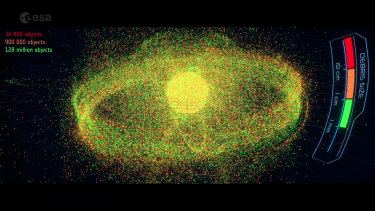
With this sharpened view astronomers can spot debris and advise countries and companies to move their spacecraft, satellites or astronauts away from danger. They are also planning to use a different high-powered laser to shoot small pieces of debris – the pressure from the laser slowing the debris so it lowers its orbit towards the Earth, hitting the upper atmosphere and eventually burning up on re-entry.
Australia has an important role in this global issue, as we monitor vast skies with space technologies that few others in the Southern Hemisphere have.
Avoiding Kessler Syndrome
It is vital we avoid causing more space junk. Since the 1950s we have sent thousands of rockets, satellites and assorted objects into space. That number is growing exponentially. Just this year, SpaceX set a record for the number of satellites sent to space on a single rocket: 143.
Given our reliance on space and the incredible potential of satellite technology, we cannot expect countries and companies to stop sending satellites into orbit, nor should we want to. But as space becomes more populated, we will no longer be able to rely on human reaction to move satellites and the International Space Station out of the way in time. More collisions will cause more debris and eventually the avalanche will be set in motion.
But what if satellites could move themselves out of the way?
Artificial intelligence (AI) can be used to create a system of satellites smarter than their predecessors, able to avoid debris and remain whole and operational.

As the amount of man-made debris in space increases, so does the possibility of a cascading series of crashes involving satellites in orbit. Credit:European Space Agency
However, if these AI-enabled satellites cannot work together, the worst-case scenario could see them catalyse the very disaster we are trying to avoid. A satellite avoiding a single screw could shift out of the way, causing another satellite to move and another until a domino effect causes crashes – perhaps into the International Space Station, our slowest-moving asset and home to our astronauts.
Swinburne University of Technology has partnered with professional services network EY (formerly Ernst & Young) and their space technology and AI lead for Oceania, Dr Olivia Sackett, the CSIRO’s data science research and engineering arm, Data 61, and the Australian space industry consortium SmartSat CRC to develop an industry standard for AI in space, so that systems from different owners can operate in the same space, literally.
The project, called ‘Responsible AI in Space’, is a collaboration between space scientists, law and policy experts, the space industry, government and practitioners in the emerging field of AI assurance.
Loading
AI assurance is about maximising the benefits and minimising the harms associated with AI-enabled systems. The team will create a framework that companies, satellite operators, regulators and insurers can use to assess the trustworthiness of AI-enabled systems in space.
Responsible AI is the new final frontier in space – and it may be our final hope to preserve it too.
Professor Alan Duffy is an astronomer and director of the Space Technology and Industry Institute at Swinburne University of Technology.
The Morning Edition newsletter is our guide to the day’s most important and interesting stories, analysis and insights. Sign up here.



























